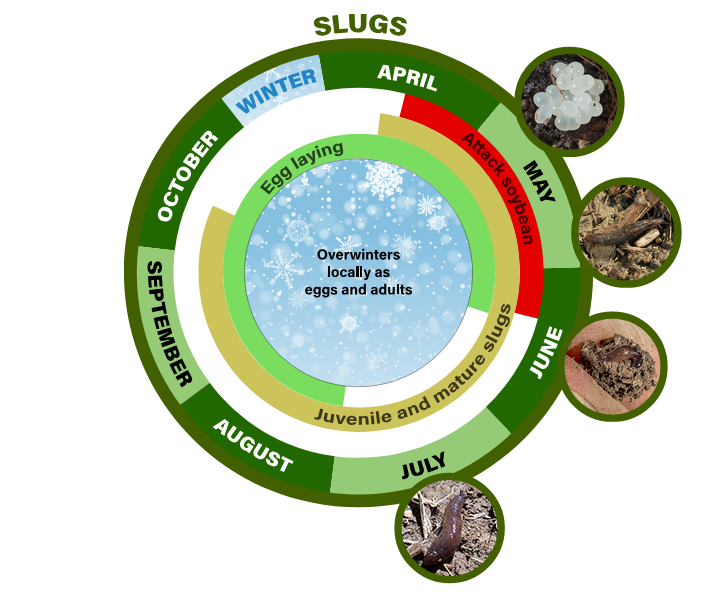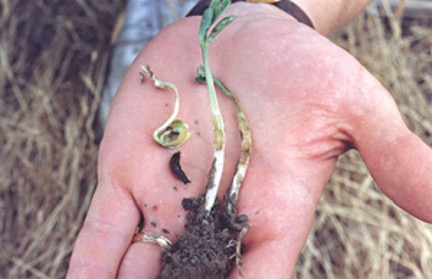Slugs (Soybean)
Primarily Deroceras spp.
Search the Pest & Crop Newsletter

The ability to see these full-sized life-cycle images is currently disabled to resolve an issue.
Appearance and Life History
Slugs are found throughout the eastern United States in almost every cropping system and feed on decaying organic matter and plant foliage. Their activity is favored by minimum tillage, plant residue on the soil surface and cool, moist conditions.
Slugs are soft-bodied, legless, slimy, white, gray, or black gastropods (not insects). Some species measure up to 4 inches (10 cm) in length but most are 1/2 to 1-1/2 inches (13 to 38 mm).

Photo by B. Christine

Photo by J. Obermeyer
In the spring, translucent round eggs are laid in masses in damp places. These eggs hatch in about a month. The juvenile slugs are very similar to mature slugs except for their size. They develop slowly and live a year or more.
Slugs overwinter as both adults and eggs in soil in the Midwest. Slug populations tend to be greatest in conservation tillage systems using cover crops, and very weedy fields. The high surface residue, moisture, and lack of soil disturbance is favorable for their development.
Damage
Slugs usually feed on the lower part of the plant, eating partly or completely through the hypocotyl and cotyledons. Unifoliolate leaves may be damaged before unrolling, making them appear distorted and tattered. Stand losses by slugs occur when fields are generally too wet, and not ideal for planting, thus resulting in seed furrows that do not properly close during planting operations. In this situation, slugs are able to feed day or night on the seedlings, often destroying plant tissue at, or below, the growing point(s).

Photo by J. Obermeyer

Photo by J. Obermeyer
Sampling Method
- Sampling for slugs in soybean is not to be considered routine.
- If damage is suspected or seen, check 20 plants in each of 5 areas of the field.
- Record the number of plants showing damage and/or dying.
- Slug counts can be taken day or night.
- Day sampling:
- 5 linear feet (1.5 m) of row in each of 5 areas of the field. Check on each side of the row until 5 feet (1.5 m) of row have been covered.
- Turn over and inspect clods and pieces of plant residue in each sampling area for slugs. Look for the presence of slime trails
- Record the number of slugs found in each sampling area.
- Night sampling:
- Count slugs on plants or soil surface. Use a flashlight to illuminate the sampling area.
- Keep a record of all samples taken and note if taken during the night or day.
Management Guidelines
Soybean Insect Control Recommendations: E-series 77-W (PDF)
- Reducing crop residue in slug history fields by tillage discourages slug-buildup. Zone tillage or row sweepers at planting may reduce slug damage by encouraging soybean growth and the drying of the soil. Early planting and crop emergence, before spring egg hatch, will allow most seedlings to advance beyond the soybean’s vulnerable stage to slugs. However, this practice will only be successful if soils are suitable for planting. Poorly sealed seed furrows can result in severe slug damage and crop stand losses. Where replanting is necessary, the field or area should be tilled first to disrupt the slugs’ environment.
- There are no established economic thresholds or rescue treatments for slug control. Insecticides, including seed treatments, are ineffective because slugs are not insects! If the stand is being threatened, control is warranted if the slugs are still present and feeding and weather conditions (rainfall) still favor slug activity. Pelleted chemical baits are available for slug control. However, these may be inconsistent, expensive, and difficult to evenly dispense over the field.
